Wild Life Spring Sensations

Appreciating nature’s acrobats of the sky

Dynamic coastal landscapes
Discover the shifting nature at one of our oldest reserves

Brilliant birds
Learn how we are helping to safeguard the future of ground-nesting birds

Spring 2024 The magazine for Hampshire & Isle of Wight Wildlife Trust members
Hampshire & Isle of Wight Wildlife Trust
DIVERSE HABITATS
COASTAL MANAGEMENT
Digital copies of Wild Life magazine are also available. If you would prefer to receive a digital copy, please email membership@hiwwt.org.uk and we will update your record.
Spring is for nesting

Spring has finally sprung. Waking up to sunshine, warmth and bird song always fills me with enthusiasm for the day ahead, and of course anticipation for the new wildlife which this season brings.
Spring is much more than just a season. It is also a verb that means ‘to rise, leap or move’ and there are certainly lots of animal actions which come to mind when thinking of these words, from ‘leaping salmon’ to ‘skylarks rising’.
In this spring issue of Wild Life, we celebrate birds as they move around and arrive in all their forms. Whether this be
from migration or hatching from an egg. Did you know that whilst spring is nesting season for birds, not all of t hem nest in trees.
Lots of birds nest on the ground, and here in Hampshire and the Isle of Wight, we are lucky enough to have some really important ground-nesting birds. However, these birds need undisturbed ground to raise the next generation. Turn to page 22 to find out why.
Birds, like all species, are becoming under increasing pressure from loss of habitat. On page 18 we examine the future of one of our - and the south coast’s - most important reserves for birds: Farlington Marshes.
I’d like to take the opportunity, in my first Editor’s Welcome, to announce that we are currently looking into how we can enhance your nature reserve experience.
In the ever-evolving world of conservation, our nature reserves play a pivotal role in preserving biodiversity and providing sanctuaries for countless species.
To enrich the visitor experience, whilst ensuring the protection of wildlife, we are planning the introduction of new signage installations to serve as educational tools, fostering a deeper connection
Hampshire & Isle of Wight Wildlife Trust
Editor Helen Skelton-Smith Designer Keely Docherty-Lee
● We manage 67 nature reserves.
● We are supported by over 28,000 members and friends, and 1,500 volunteers.


we fundraise.
Cover image avocet © Shutterstock
between visitors and the natural world around them.
As we embark on this exciting venture, we invite you to be part of shaping the future of the nature reserve experience. Your feedback is invaluable in ensuring that these innovations align with your expectations and contribute to a more enriching visit.
Please take the time to fill in a brief online questionnaire. Your insights will help us refine the signage, making it more accessible, informative, and enjoyable for everyone. The questionnaire can be found here: hiwwt.typeform.com/ interpretation
Thank you for taking the time to help us better understand how to connect with everyone who visits our reservesyour views matter.
As a member, your continued support helps us to safeguard all our wonderful nature reserves, habitats and species which call them home. Thank you.
 Helen Skelton-Smith, Editor
Helen Skelton-Smith, Editor
Email: webmarketing@hiwwt.org.uk

You can change your contact preferences at any time by contacting Hampshire & Isle of Wight Wildlife Trust at:
Email membership@hiwwt.org.uk
Telephone 01489 774400
Address Beechcroft House, Vicarage Lane, Curdridge, Hampshire SO32 2DP
For more information on our privacy policy visit hiwwt.org.uk/privacy-notice
Please pass on or recycle this magazine once you’ve finished with it.
2 Wild Life | Spring 2024
to
the
in the way
Hampshire & Isle of Wight Wildlife Trust is registered with the UK Fundraising Regulator. We aim
meet
highest standards
Wild Life is the membership magazine for Hampshire & Isle of Wight Wildlife Trust.
Registered charity number 201081. Company limited by guarantee and registered in England and Wales No. 676313. Website hiwwt.org.uk


4

18

WILD SEASON
4 Your wild spring
The best of this season’s nature, including spring bird arrivals.
8 Reserves spotlight
Take a closer look at Blashford Lakes Nature Reserve in the New Forest.
10 Wild news
A round-up of the latest Trust news, successes and updates.
16 Team Wilder
We share the story of young people taking action for nature.
FEATURES
18 Coastal management
We examine the shifting nature of our coastal landscape, featuring Farlington Marshes Nature Reserve.
22 Ground-nesting birds
How we are helping to safeguard the future of ground-nesting birds.
REGULARS
14 A word from our CEO
Introducing a new column from Debbie Tann MBE, Hampshire & Isle of Wight Wildlife Trust Chief Executive.
17 Photo club
Celebrating our two counties through our favourite staff photos.
26 Migrating birds
From the sand martin to the redstart, discover six places to find spring migrating birds.
28 Wildlife gardening
Advice on how to grow a delicious herb garden from garden designer, Arit Anderson.
30 My wild life
Jamie Marsh talks about his long association with the Trust, and how working in conservation is much more than a career: it’s a lifestyle choice.
8
16
Wild Life | Spring 2024 3
YVONNE WILLIAMS
GILLIAN DAY
JEREMY ROBBINS
KATE GARNHAM

Your wild spring
The best of the season’s wildlife and where to enjoy it.
4 Wild Life | Spring 2024
YOUR WILD SPRING


SPRING SPECTACLE
Lapwings: the handsome wader with
many names
Male lapwings put on dramatic aerial displays, tumbling through the air, accompanied by their piercing ‘peewit’ call, which gives them their other, common name: peewit. This unusual flight can be described as ‘floppy’. Their large, rounded wings move slowly, feathers spread and showing flashes of the white feathers underneath; the slow wingbeats can make them appear to float and this is a very recognisable feature of the lapwing. Springtime flocks dart and zigzag in the sky, these amazing aerial displays confuse predators as their flight and mixed colouring make each bird hard to focus on.
As well as ‘lapwing’ and ‘peewit’, they are also known as the ‘green plover’. Its Latin name, Vanellus, means ‘little fan’ and refers to the floppy, flapping flight. The name lapwing is thought to derive from an Old English term meaning ‘leap with a flicker in it’ because the dense winter flocks appear to flicker between white and black when the birds flap their wings.
Main image: Lapwings are the most widespread breeding waders in Britain.
MARK HAMBLIN/2020VISION
Inset: Lapwing chick
MARK HAMBLIN/2020VISION
Lapwings can be recognised by their long crests, black and white patterns, and very broad, round wingtips. At first glance, their plumage may look dark and dull but look a little closer, or watch it catch the light, to see the iridescent sheen of greens and purples. Both males and females have a crest on their heads, although the males are longer and showier.
Last year, an impressive 25 lapwing chicks fledged at Testwood Lakes Nature Reserve. Turn to page 22 to discover more about our conservation efforts for lapwings and other ground-nesting birds.
SEE THEM THIS SPRING
Testwood Lakes Nature Reserve
This reserve is a haven for wading birds, including lapwing and oystercatcher, which feed and roost on the lakes during spring.
Farlington Marshes Nature Reserve
This reserve is renowned for its bird life and is a go-to destination for seeing a huge array of species throughout the year. During spring and summer, it is a vital breeding ground for waders including lapwing and redshank and more recently avocet.
Wild Life | Spring 2024
5
Space for sand martins to thrive

Thousands of sand martins migrate from their wintering grounds, south of the Sahara, to our shores each year. Hundreds descend on Blashford Lakes Nature Reserve, arriving mid-March to feast on the abundant insect life.
Naturally, they excavate their nest sites in sandy cliffs or banks next to waterways. However, this habitat type is becoming increasingly uncommon inland due to changes in land use. For example, riverbanks are often reinforced with man-made materials to reduce flood risk, leaving little space for sand martins to make their burrows.
In 2007, the Trust gave the birds a helping hand by installing an artificial nest wall next to the reserve’s largest lake, Ibsley Water. Hanson Concrete Limited kindly provided materials while a dedicated team of volunteers helped staff and contractors with the labour. 185 tubes were installed, each with a small chamber at the back to give the sand martins space to construct their simple nests, which they line with feathers and vegetation. The project was an instant success as the birds took up residence and bred in the wall in the first season.

Each autumn, after the birds have started their long journey back to Africa, the tubes containing nests are counted, which gives an indication of the sand martins’ breeding success. The old material from each tunnel is raked out and repacked with fresh sand (kindly donated by Tarmac) ready for the next breeding season; this helps reduce the parasite load and therefore support the health of the sand martin colony. During the 2023 season, 137 tubes were found to contain nests and we suspect many of the pairs managed to rear second broods.
However, it wasn’t all plain sailing for the martins this season. An unexpected visitor was found taking up residence in one of the nest tubes. A grass snake was spotted peering out from the wall, most likely in search of an easy meal. Thankfully for the sand martins, this was at the end of summer when most of the chicks had fledged and they were therefore able to avoid the predator.
A huge thank you to all the volunteers, donors and partners for making the sand martin project a success and helping to safeguard the future of Blashford’s sand martin colony.
Oers in spring
Seeing the signs of otters is far easier than seeing the animals themselves. Along riverbanks and sandy banks, look for slipways made by a belly sliding otter and five-toed footprints (about 6-7cm long) and droppings or ‘spraints’. Otters leave spraints in prominent places, such as fallen trees, weirs and bridges, as ‘scented messages’, helping them to find mates and defend territories. They contain visible fish bones and have a distinctive, pleasant smell, reminiscent of jasmine tea.
An otter has recently been spotted at Blashford Lakes Nature Reserve. Otters pass daily through Winnall Moors Nature Reserve and can also be seen in the floodplain meadows, marshes and reedbeds (which are a favourite hunting ground) at Lower Test Nature Reserve.
6 Wild Life | Spring 2024
YOUR WILD SPRING
ANDY ROUSE/2020VISION
CLAIRE NORRIS
URBAN FIELDCRAFT
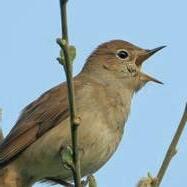
HEAR THIS
The arrival of nightingales is an eagerly awaited sign of spring. Despite their name, nightingales don’t only sing at night - they are at their loudest first thing in the morning.
SPECIES SPOTLIGHT
Redshank

SMELL THIS
In April and May, ancient woodlands are awash with the white, starry flowers and smell of wild garlic. Millions of bulbs can exist in just one wood.

These noisy birds make a delightful soft piping sound but they are also extremely wary, and will alert other birds to the presence of predators with a persistent shrill whistle.
The redshank lives up to its name as it sports distinctive long, bright red legs - the spotted redshank is the only other wader that also has bright red legs but it is slightly larger, with longer legs and a longer bill.
This noisy wader also has a straight bill which is red at the base and black at the end. Some birds undergo seasonal colour change, and the redshank’s beautiful grey-brown plumage also incorporates brown and black spots during the breeding season. Whilst in flight, it also shows a white triangular wedge up its back and a wide, white triangle on its rear.
The redshank is a typical wader, feeding in shallow water around lakes, marshes, mudflats and coastal wetlands. It forages for food by probing its bill into the sandy and muddy shores, and likes to eat insects, spiders, worms and crustaceans.
See them this spring
Redshanks reside in the UK all year round, but their numbers swell in winter when
large numbers fly here from Iceland to spend the winter around the coasts.
Redshanks breed between April and June. They prefer to create their nests on open marshes, mires and saltmarshes. They tend to nest in close proximity to other nesting pairs to help form a communal territorial defence against predators.
The male tends to build the base of the nest, which is then covered with grass stems, and lined with twigs and leaves by the female. The monogamous pair will together share the duties of incubating their eggs for up to 24 days.
In common with all waders, the chicks can walk and feed as soon as they leave the nest, which can be as quick as 24 hours after hatching. However, this does make them vulnerable to predators, so it is vital that they use the surrounding tall vegetation to hide in. The adults will continue to care for them until they fledge, which is usually around 23-25 days after hatching.
Queen bumblebee
The queen bumblebee is the only member of the colony to survive the winter. She emerges in spring to gorge on early nectar and pollen before hunting out a nest site.

Violet oil beetle
Adults can be found from March through to July in coastal grasslands, woodlands and wildflower-rich meadows, which are also an important food source for pollinators including bees.

Brown hare
Brown hares are at their most visible in early spring when the breeding season encourages ‘boxing’. If you spot brown hares ‘boxing’ in the fields, it is most likely to be a female warding off the advances of an amorous male, not two males fighting.

Wild Life | Spring 2024 7
ROSS HODDINOTT/2020VISION
CHRIS GOMERSALL/2020VISION
ANDREW PARKINSON/2020VISION
VAUGHN MATTHEWS
JOAN BURKMAR
IAN CAMERON-REID

Discover Blashford Lakes
Situated in the Avon Valley, Blashford Lakes is one of our oldest nature reserves. Created from a series of flooded gravel pits, the 150-hectare site includes a unique mix of habitats comprising lakes, woodland, grassland and reedbeds. ousands of birds visit all year round, and the reserve is also a haven for invertebrates, fish and specialist plants.
The Blashford Lakes complex includes the largest inland body of water in Hampshire, Ibsley Water. This is a prominent and important stopover site for a range of migrant bird species. During the winter months, notable numbers of wildfowl escape the cold harsh conditions of their northern breeding grounds for the comparatively mild conditions of southern England. In particular, Blashford sees large numbers of gadwall, pintail, wigeon and shoveler during this period.

Water, water, everywhere
The majority of the site is water. Ibsley Water and Ivy Lake are packed with weed for dabbling and diving ducks, as well as fish which are predated by a variety of birds including great white egrets, goosanders, kingfishers and terns, while the silt ponds are great for odonatan (insects which include dragonflies and damselflies).
The marginal areas and wetland habitats include wet woodland / alder carr, reedbed and fen. These are important for a range of birds including reed bunting, siskin, bittern, water rail and a variety of warblers.
Did you know?
The unusual female hazel flower is hard to spot due to its small size and being enclosed in a tiny brown bud, with only pink styles protruding which resemble tiny sea anemones.
A unique mix of habitats
The site includes an interesting array of terrestrial habitats including acid grassland and woodland, and scrub. There is also a noteworthy mix of habitats associated with post-industrial works which includes bare shingle (good for ground-nesting birds such as terns and oystercatchers), sand, tarmac and ‘lichen heath’. In the unusual lichen heath habitat, delicate communities of fungi, lichen, grasses and other flowering plants are slowly colonising this area of nutrient poor ground, which was used to infill a former gravel pit as part of quarry restoration works.
Habitat management
A variety of conservation measures help maintain the matrix of different habitats.
For example, coppicing helps increase the structural diversity in the woodland, while much of the wood used for dead hedging and log piles are left in-situ as they are great for fungi. Scrub clearance takes place on the islands for the benefit
8 Wild Life | Spring 2024
PETE WHITLOCK
of birds including ground-nesting gulls, oystercatcher and terns. New Forest ponies graze the shoreline of Ibsley Water, which keeps the habitat suitable for wildfowl and waders. Willow and birch are also thinned in key areas to maintain reedbed and fen habitats.
In the immediate future, the Trust, alongside other lake users and partner organisations, will continue to tackle invasive non-native species (INNS) such as Japanese knotweed, American skunk cabbage and Himalayan balsam, as well as continuing to improve infrastructure and access. Ash dieback will also be removed from near paths but kept as deadwood / chance for resistance elsewhere. Disease resistant elms will be planted where the ash trees are removed – this species is particularly good for white letter hairstreak butterfly (yet to be recorded on site).
Spring species
Spring is a fantastic time of year for bird watching, as migrants move between their wintering and breeding grounds and use important stop-over sites like Blashford Lakes on the way. It is also a good time to see returning migrants including the garden warbler - look out for this shy bird in the low trees and shrubs where it will build nests from grasses.
Common terns also start breeding on the tern rafts, which are deployed on Ivy Lake each spring. This is carefully timed as otherwise black headed gulls take all the best spots before the terns arrive.
Depending on weather conditions, reptiles start to come out of hibernation around this time too. Adders are typically the first to come out. Spring mornings are the best time to spot them as they spend the early part of the day basking in the
sun. Toads typically breed in January and February with newts arriving back in the ponds a bit later, usually March.
Later in the year, look out for little ringed plover, a summer visitor who also breed at Blashford. This wader lays its camouflaged eggs on bare shingle and is often associated with reservoirs and gravel pits.
Notably, some of the less common species which have visited in the past year include black tern, osprey, ring-billed duck, garganey, wood sand piper, grey phalarope and hobby. The black-winged stilt was also seen. A rare visitor to the UK, this elegant wading bird is being affected by the warmer weather in southern Europe, which is drying out wetlands where they would normally nest, pushing them north to find more suitable sites.
There are excellent viewing spots including six bird hides, a viewing platform and the new boardwalk (located near Ivy south hide and which forms part of the reserve’s ‘wild walk’).
Inspiring the next generation
The Education Centre offers the chance to scroll through wildlife cameras, read about the reserve, and check out the events board.
Hundreds of children (from colleges, schools, home educational and uniform groups) visit each year and participate in activities led by staff, supported by a fantastic team of education volunteers. Monthly events for different age groups also take place and events also run throughout holidays. Free seasonal trail sheets are available for younger visitors.
Friendly volunteers can be found at the Welcome Hut, and can help with directions plus hints and tips on where to head in the reserve.
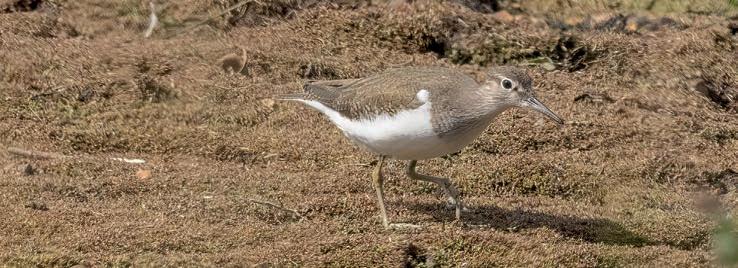

Blashford Lakes recently benefitted from a gift in the Will of local resident Elisabeth Purvis. Thanks to Elisabeth, we have been able to carry out repairs and upgrades to the hides and pathways onsite, and the volunteers have new tools and kit to help them keep the reserve in great condition for both wildlife and visitors.
NOW YOU DO IT Visit Blashford Lakes Nature Reserve
KNOW BEFORE YOU GO
Location: Ellingham Drove, Ringwood, Hampshire, BH24 3PJ
OS Maps grid reference:
Main car park: SU 151 083
Education Centre: SU 151 079
what3words reference:
starfish.sideburns.admiringly
Parking: The main car park is on the north side of Ellingham Drove. Education Centre parking is on the south side of Ellingham Drove. Nearest bus station: Ellingham Cross (1/3 mile).
Size: 150 hectares.
Getting around: Public footpaths enter the site from the south (Ringwood) and east (Moyles Court).
THINGS TO DO
Visit the bird hides – There are six bird hides in the reserve, with additional screens in various locations.
Walk the ‘Wild Walk’ – This lovely circular accessible route is suitable for all ages, and provides a great first ‘loop’ to get your bearings for first time visitors.
Visit the viewpoint over Ibsley Water – a beautiful vista from which to spot wildlife.
WILDLIFE TO SPOT
Great crested grebes: Seen throughout the year, these beautiful birds can sometimes be seen gifting each other shoots and reeds from the lake as part of their courtship during the spring and summer months.
Water rail: Elusive bird of freshwater wetlands, heard more often than seen. Its distinctive call (similar to that of a squealing pig) can be heard coming from reed beds and wet woodland across the reserve. The best chance of seeing this species is in front of Ivy North hide during the winter months.
NATURE RESERVE SPOTLIGHT Wild Life | Spring 2024 9
DAVID CAMP
Common sandpiper
WILD NEWS
All the latest news from Hampshire & Isle of Wight Wildlife Trust
First surveys for small but mighty dung beetles

Our first dung beetle surveys have taken place at Wilder Little Duxmore and Wilder Nunwell, the Trust’s two rewilding sites located on the Isle of Wight.
Dung beetles are fantastic indicators of ecosystem health and biodiversity, responding quickly to environmental change. They also play an important role in nutrient dispersal and cycling in the soil, improvement of soil structure and parasite regulation.
These often overlooked or simply unnoticed insects prove that you don’t have to be the size of a European bison to have a landscape-scale impact. Also deemed an ‘ecosystem engineer’, the humble dung beetle, when in healthy numbers, performs an incredible array of natural functions that underpin soil
health and support a large range of animal and plant life, thus helping boost biodiversity.
In a rewilding context, an assessment of dung beetle diversity over time can help inform how the site is changing and responding. We will continue to regularly carry out dung beetle surveys at our rewilding sites to monitor the populations, informing us about changes to species assemblages as the sites begin to evolve. In combination with soil nutrient assessments and earthworm surveys, this will help us understand how healthy the soils are as they transition from nutrient-rich post-arable fields to natural, functional ecosystems.
The Trust acquired Wilder Little Duxmore in 2020 and acquired a long-term lease of part of the Nunwell Estate in 2022.
Didknow?you
There are an incredible 60 dung beetle species in the UK. They are not the famous ‘ball rollers’ we typically see in warmer countries, but instead live inside the dung pile or in the soil beneath it.
The survey method involves adding dung to a bucket of water and gently breaking it up with a spade, allowing the dung beetles to oat to the surface. They can then be carefully scooped up using a sieve. Specimens are collected and taken back to a lab to be identi ed under a microscope.

10 Wild Life | Spring 2024
AGGIE THOMPSON
DAVID THOMPSON

Next steps for Britain’s beavers
The Trust’s work preparing a wild beaver release licence continues - despite the then Environment Secretary Therese Coffey announcing in October 2023 that species re-introductions (and beavers specifically) were not a priority.
The Trust is campaigning at a national level for the overdue England Beaver Strategy that needs to encompass co-existence with wild living beavers and licencing for wild releases. The draft ecological assessment has been completed, a huge undertaking that assesses the likely impact of beavers on our Isle of Wight European designated sites, particularly the Solent and Following the Trust’s parliamentary roundtable event, where we discussed with MPs how they can help drive forward chalk stream protections, we’ve been actively engaging with schools to empower the next generation of nature advocates.
Southampton Water Special Protection Area, the Solent and Isle of Wight Lagoons Special Area of Conservation and Alverstone Marshes SSSI, as well as Priority habitats and species in the Eastern Yar floodplain and immediate surrounds.
The next steps are to prepare a socioeconomic assessment and to further engage with the local farming community and riparian landowners to better understand their perspectives and to ground-truth some of our habitat mapping and risk assessments.
Nicola Wheeler, the Trust’s Beaver Recovery Project Officer, recently attended
a Natural England beaver licence training course, and is well equipped with the knowledge and understanding as well as the requirements for managing beaver dams and burrows if they occur in undesirable places.
The Trust is currently establishing a beaver project volunteer task force, on the Isle of Wight, in order to help carry out baseline ecology surveys, map important infrastructure and undertake invasive Himalayan balsam control on some of the Trust’s East Yar sites on the Isle of Wight, during the summer. Please email nicola.wheeler@hiwwt.org.uk for details if you would like to volunteer.
Children taking chalk stream action
stream protection resonates across generations.
At Otterbourne Primary School, an enthusiastic group of students, aged between nine and 11 years old, passionately raised their voices for chalk streams, inviting Steve Brine MP to listen to their compelling speeches outlining the importance of taking action for our rivers.
It was heartening to witness the enthusiasm of these young advocates, demonstrating that the call for chalk
We are awaiting the release of the government’s Chalk Stream Recovery Pack which will set out how they plan to put chalk streams into recovery and we hope to see some of our campaign asks included. As we eagerly anticipate this release, if you took action last year and emailed your MP, please make sure you keep following up with them and ask that the Chalk Stream Recovery Pack has the highest ambition possible to provide better
protections and enforcement for these invaluable riverine habitats. For information, please visit: www.hiwwt.org.uk/rivers

NEWS
Wild Life | Spring 2024 11
RUSSELL SAVORY
A new conservation centre for endangered white-clawed crayfish has opened at Wildheart Animal Sanctuary on the Isle of Wight.
Ex-situ conservation of this native species is very important – captive breeding and the release of whiteclawed crayfish is a recognised global conservation strategy to help halt



Conservation centre opens on the Isle of Wight
the decline of this keystone species. It is suspected that the species has undergone a global decline of between 50-80% throughout its entire range.
The centre is the first of its kind on the Island and will play a significant role in the delivery of the Trust’s Southern Chalkstreams Project, which aims to protect Hampshire’s unique chalk stream
habitats, with a focus on the health of these environments and the whiteclawed crayfish.
The crayfish raised in the centre will support the project’s objectives through the supplementation of our existing populations or their release into safe havens or ark sites. It is hoped the released crayfish will help secure the long-term survival of the species in Hampshire, whilst enhancing wider biodiversity at these sites.
There is also the possibility of establishing the species on the Isle of Wight, ultimately helping increase the security of white-clawed crayfish in the region. However, this would involve careful assessment and consultation with a range of professionals and the public, to ensure that any future releases are in balance (or enhance) with the species and habitats these locations currently support.
The centre also provides a unique experience, giving visitors the opportunity to meet and learn about this rarely seen native species. In the future, the centre may also house berried (egg-carrying) female crayfish.
The project received funding from the Watercress and Winterbournes Landscape Partnership Scheme, with generous support from the National Lottery Heritage Fund.
Important woodland and meadows joins the Trust

In 2023, the Isle of Wight estate expanded with the acquisition of two new nature reserves: Kittenocks meadows and woodland adjacent to Swanpond Copse.
Kittenocks meadows is nine hectares of stunning unimproved lowland meadow and 1.5 hectares of semi natural ancient woodland. The meadows are truly stunning, floristically diverse and full of invertebrates. They are managed through hay cutting and aftermath grazing with a conservation style approach to soften the impacts to benefit all wildlife of the site. This was an important acquisition for the Trust as the site was at risk due to it being undesignated so other land uses could have resulted in the site being lost.
This reserve will become a sanctuary site with wildlife at its heart. Facilitated access will be made possible through Trust-led guided walks and educational visits.
We were also in the fortunate position to be able to purchase woodland adjacent to our existing Swanpond Copse reserve. JIGSAW plantation covering 15.7 hectares has now extended the reserve to create a bigger, more robust site with improved access, which will greatly assist with the management of the site.
These young blossoming woodlands have done extremely well due to the lack of grazing pressure. Both sites were purchased thanks to gifts in Wills and generous donations.
WILD NEWS 12 Wild Life | Spring 2024
KATE GARNHAM
Principal Ecologist Dr Ben Rushbrook inspecting the white-clawed crayfish, after arriving from a hatchery run by conservationists from Bristol Zoological Society.

First year success for Solent Seascape Project
It’s been an exciting first year of the Solent Seascape Project, an innovative and ambitious multi-year and multipartnership project which aims to restore seagrass meadows, oyster reefs, saltmarsh and seabird nesting habitats to the Solent region.
The Solent waterway is one of the most heavily used in the UK and has been significantly degraded over the years. Half of its saltmarsh area has been lost since the 1860s and native oyster populations have declined by 95%, leading to the collapse of the fishery. Our seagrass meadows in the Solent are also in poor condition and nesting islands for seabirds are being lost to erosion and sea level rise.
However, despite this, the Solent still supports high levels of biodiversity, providing a home for an array of incredible marine life and wintering ground for over 125,000 ducks, geese and waders.
Restoration efforts are building momentum and as well as leading on the community engagement elements across
the project, we are working in collaboration with Project Seagrass to actively restore 7 hectares of seagrass across the Hampshire and Isle of Wight coastline.
In the first year, we have been busy collecting data on the health and condition of our existing seagrass meadows in the Solent, as well as mapping potential areas for restoration trials. We have collected over 30,000 Zostera marina seeds with the help of our brilliant Solent Seagrass Champion volunteers. Half of these will be used for the Solent Seascape Project and the other half will be used for the Solent Seagrass Restoration Project.
The seeds have been kept safely in a cold, dark, high-salinity storage aquarium at the University of Portsmouth’s Institute of Marine Science, to put them in a state of dormancy over the winter months. The seeds will be planted in the spring, with the hope that conditions will be better for seedling emergence and growth. Restoration success will be monitored throughout year two of the project.
Completing the world’s toughest row
Congratulations to Team Mermaid Atlantic for completing the Atlantic Challenge: the World’s Toughest Row.
The Atlantic Challenge is the ultimate test in strength, endurance and character, racing 3,000 nautical miles from the Canary Islands to the Caribbean. The team faced many obstacles during their 43 days, 17 hours and 58 minutes at sea, including gusts in excess of 30 Kts and a broken dagger board.
Comprising three friends from the Isle of Wight, Team Mermaid Atlantic (Xavier Baker, Chris Mannion and Paul Berry) were inspired to complete the challenge whilst raising awareness and fundraising for the Trust’s seagrass restoration project, Surfers Against Sewage and The Seahorse Trust. So far, they have raised over £18,000.

Ponies, pigs and ca le provide mixed grazing

Last year saw the introduction of our first grazing animals at the Trust’s Wilder Duxmore rewilding site on the Isle of Wight.
We have now purchased three Exmoor ponies - two one-year-old geldings, Luther and Logan, and a three-year-old mare Juniper.
These will be on site permanently and during 2024, we hope to introduce another two older mares to give us a small herd of five ponies. They are already doing amazing work browsing and grazing across the site, creating structural
diversity and a myriad of habitats and niches for wildlife to utilise.
Mixed grazing is key and so working in partnership with the Nunwell Home Farm, we are also using their Belted Galloway cattle and pedigree Berkshire pigs. The cattle and pigs will graze in pulses through the year to provide low density grazing in addition to the ponies.
The aim is to replicate a natural system mimicking the transient nature of grazing animals.
NEWS
Wild Life | Spring 2024 13
KATE GARNHAM
WORLDS TOUGHEST ROW
LAURA MCCONNEL
News in brief
A word from our CEO
Spring is my favourite time of year as the season of new beginnings, bringing with it optimism for the year ahead. Given the importance of the next 12 months, we’ll be doing all we can to ensure that optimism is well founded.
With a general election looming, our focus must be on striving to place nature’s recovery at the heart of the agenda and of manifesto pledges for all the main political parties. At a local level, we are working hard to try to enshrine real ambition into the new Local Nature Recovery Strategies for Hampshire and the Isle of Wight.



2024 is going to be an important year and with the ongoing threats of the climate and nature crises, we always have to look ahead and focus on how to make the most impact through our campaigning, education and conservation work on the ground.
However, I was somewhat forced to stop, reflect and look back on our achievements during the Christmas break as a result of the shock (but lovely!) news that I had been awarded an MBE in the King’s New Year Honours List for services to wildlife and the natural environment!
This was a truly humbling experience and one which filled me with pride. I am beyond grateful for this wonderful accolade which is a reflection on the brilliant team of staff, trustees, volunteers, members and supporters we have here at the Trust.
Reflecting on the 25 years that I’ve worked for the Trust – more than 15 of which have been as Chief Executive –I am so proud of how far we have come in that time. We all know that the UK has become one of the most nature depleted countries in the world and our biodiversity is in serious trouble, but through the incredible work of my dedicated and passionate team we are helping wildlife to bounce back across Hampshire and the Isle of Wight.
It can sometimes feel like an uphill struggle as we strive to protect wildlife from the impacts of development, intensive land use, pollution, recreational pressure and climate change.
But thanks to the generous and loyal support of our members, funders and partners, we are delivering ambitious rewilding and nature restoration projects, and embracing innovations like nature-based solutions, to help wildlife recover and thrive on our nature reserves and beyond.
Just a few of the notable achievements during my time at the Trust are reflected in the timeline opposite.
So, while it is a big year ahead with many challenges, there is reason for optimism and hope this spring. And, together, we can and must work to bring about the change we all want to see.
 Debbie Tann MBE, Chief Executive X @Debbie_Tann
Debbie Tann MBE, Chief Executive X @Debbie_Tann












14 Wild Life | Spring 2024
WHAT’S ON
Literature Festival: Tales from the Riverbank

Celebrate Hampshire’s chalk streams
A literature festival celebrating Hampshire’s chalk steams will be held this June, in locations across north and central Hampshire. Attendees will be treated to guided walks and talks by prominent nature writers, as well as chalk stream-themed writing workshops for children and adults.
The Watercress and Winterbournes Landscape Partnership Scheme protects, enhances, and celebrates seven chalk streams, with support from the National Lottery Heritage Fund. This year’s literary activities are a collaboration between the scheme partners and Hampshire Library Service.
Sat 1 June, Sun 9 June,
Sun 16 June and Sat 22 June
Children’s Poetry Workshops
Children aged 7 – 11 years old can join author and storyteller Amanda KaneSmith for a guided walk along a chalk stream. Participants will use a variety of senses to explore these special habitats, and take part in a poetry workshop inspired by the streams.

Locations: Choose from River Arle, Upper Test, and Upper Anton chalk streams.
WATERCRESS & WINTERBOURNES
Sun 2 June, Sat 8 June, Sun 23 June and Sat 29 June
Chalk Stream Writing Workshops
Teenagers and adults can join author and storyteller Dawn Nelson for a guided walk along a chalk stream. Participants will then learn creative writing skills that they can use to craft their own story about the streams. Teenagers need to be accompanied by an adult.
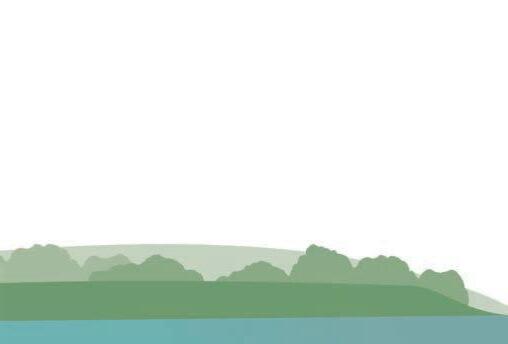
Locations: Choose from River Arle, Upper Test, and Upper Anton chalk streams.
For more information about the competition and events, visit: hiwwt.org.uk/tales Find out about the many other Trust events by visiting: hiwwt.org.uk/events
Tues 4 June
Wild Hope with Tom Moorhouse
Join author Tom Moorhouse, as he uncovers the hidden wonders of British rivers and how we can find hope for their future.
Location: John Pearson Hall, New Alresford, SO24 9AG
Sat 15 June
Water
Journeys with Ma Gaw
Join author Matt Gaw, as he explores how Britain’s rivers can inspire adventure, joy and creativity.
Location: St Mary’s Hall, Overton, RG25 3HA
Weds 19 June
Rivers of Myth with Lisa Schneidau
Join author and storyteller Lisa Schneidau, as she dives into some of the fantastical folk tales inspired by Britain’s rivers.
Location: Andover Guildhall, SP10 1NT
Weds 26 June
Finding the Flow with Amy-Jane Beer
Join author Amy-Jane Beer, as she unpacks the wonder, healing, and transformation that we can find through Britain’s rivers.
Location: Whitchurch Parish Hall, Whitchurch, RG28 7LQ
Poetry competition
Children aged 7-18 years old are invited to write a short poem inspired by the wonderful world of chalk streams. The winners will receive National Book Tokens worth up to £75, and have their poems published in a commemorative booklet. Entrants must live within the scheme area, which includes Andover, Whitchurch, Overton, and Alresford. Deadline for entries is 31 July 2024.


Wild Life | Spring 2024 15
GUY EDWARDES/2020VISION
TEAM




Welcome to Team Wilder, where this edition we share the story of local young people coming together to take action for wildlife
Creating new homes for wildlife
Ateam of young people from The Hampshire and Isle of Wight Fire and Rescue Service (HIoWFRS) Prince’s Trust Team programme planned and created new homes for wildlife on the Isle of Wight –with a little help from the Trust as part of the Nextdoor Nature Project, funded by the National Lottery Heritage Fund.
The whole of the Isle of Wight team pulled together to support the Prince’s Trust community project hosted at Wilder Little Duxmore, the Trust’s first rewilding site, on the Island last autumn.
The weather was very challenging, with some of the worst local flooding in recent history on the Island, but this did not deter the young people from approaching the tasks with enthusiasm, smiles and an excellent sense of humour. They created several new homes for nature including a wildlife pond, bug hotel and stumpery. Natural materials, timber and logs from the reserve and recycled materials were used as much as possible.
Thanks to the excess rain, the pond quickly filled and the wildlife swiftly moved into the new habitats. Solitary bees and a common darter dragonfly

have been spotted using the pond and various minibeasts have taken up residence in the bug hotel. The Trust looks forward to seeing the habitats develop and recording the species they attract.
Locally, The Prince’s Trust Programme is powered by the Isle of Wight Fire and Rescue Service, who deliver three programmes each year. The course offers young people aged between 16 and 25 the opportunity to build confidence through team challenges, work experience placement and a community project. It also gives them a chance to break down personal barriers and overcome obstacles, so they become better prepared for the world of work. They also receive a qualification in Employment, Teamwork and Community Project as well as further support with mentoring and training to help them achieve their personal and professional goals along the way.


Under the guidance of Trust staff, the young people worked on:
● Digging and creating a new wildlife pond
● Building an enormous bug hotel aka ‘The Critz’
● Building a stumpery providing habitats for insect larvae such as stag beetles
● Creating a hibernaculum – a winter refuge for hibernating reptiles and amphibians
● Assembling hazel dormouse boxes
● Building a bespoke trough planter planted with native herbs for pollinators
● Designing and illustrating some beautiful signage for each of the nature stations
In time, we hope to showcase this project to interested groups visiting the site, inspiring them to create their own versions in their respective community greenspaces. Anyone can become part of Team Wilder. It doesn’t ma er whether you’re an individual, a local business, a school or a community group, as long as you are keen to help nature. If you’d like to find out how you can get involved, please email wilder@hiwwt.org.uk or visit our website for more information.
16 Wild Life | Spring 2024
PEOPLE TAKING ACTION
ALL PHOTOS: KATE GARNHAM
Our favourite staff photos
Celebrating our two counties through photography.
Marsh harrier
Taken by Simon King, Assistant Reserves Officer (Lower Test Valley).
This individual was one of four which roosted at Lower Test Nature Reserve this winter.
Views and rainbow, Deacon Hill Nature Reserve
Taken by Andy Reeves, Trainee Assistant Reserves Officer (Central).
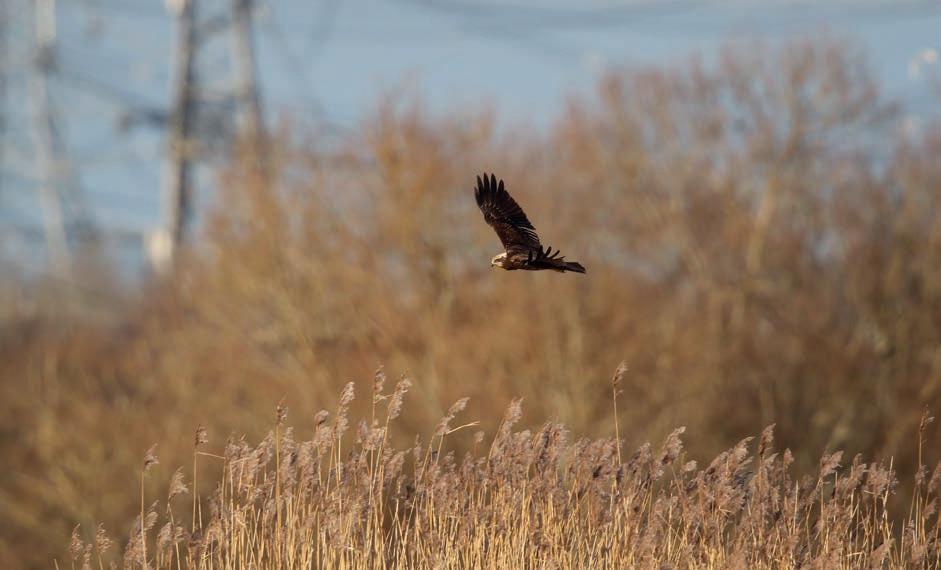

Rock pipit at Lower Test Nature Reserve
Taken by Simon King, Assistant Reserves Officer (Lower Test Valley).


Bouldnor Forest Nature Reserve
Taken by Kayleigh Ghiot, Assistant Reserves Officer (Isle of Wight).
PHOTO CELEBRATION

e shif ting nature of our coastal landscape
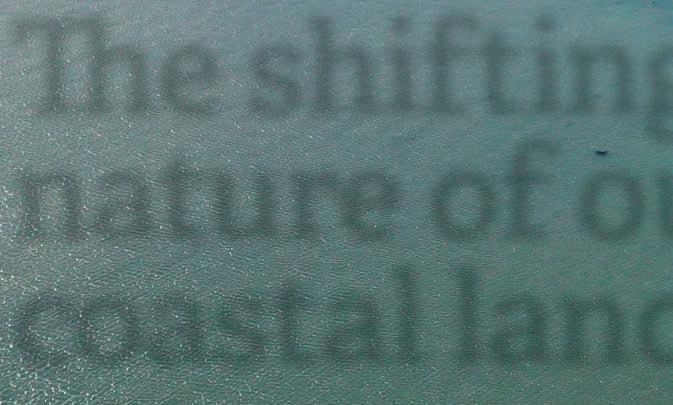

WORDS CHRIS LYCETT Former Senior Reserve Officer
Chris worked at the Trust for over seven years and successfully delivered a range of complex conservation projects in that time. Chris specialises in coastal bird ecology and the development of breeding wader and overwintering wildfowl sites across the Solent, most notably Farlington Marshes.
18 Wild Life | Spring 2024

Wild Life | Spring 2024 19 WEZ SMITH RSPB
There are few places that you can go on the busy Solent coast like Farlington Marshes Nature Reserve. Sandwiched between ever-growing development, it represents an incredibly important resource for many of our bird species, and acts as a linchpin within the three harbours of Chichester, Langstone and Portsmouth.
Thousands of birds flock here in the winter to rest and feed, while a growing breeding population of waders in the spring further heighten its importance. It is now one of the most productive sites in the Solent for lapwing and redshank. It also plays a pivotal role in all the Brent goose populations that reside in Langstone Harbour, all visiting it as part of their daily routine.
However, Farlington is in no way a secure site. Created in the 1700s by constructing a sea wall between islands, it is completely artificial, the centre being well below high tide. Sea level rise is a looming threat to many of our important coastal sites, with no room to roll them back and creation of new sites hampered by concrete sea walls. The threat to these sites is now at an all-time high.
The importance of Farlington To get an idea of how important
 ALAN DUNK
ALAN DUNK

Drone photographs taken before and a er the four new shingle islands were created.

Farlington is you have to take it in context to the south coast. Between Hayling Island and the New Forest is some of the most developed coastline in the UK. Housing and businesses take up most of the land meaning that flood protection is mandatory to secure its future against climate change. This means hard infrastructure and an immobile coastal edge. Historically, our coastline would have been a continually shifting landscape as the power of the tides eroded and moved sand and shingle, reaching further inland at some points and creating more land in others, as the moving sediment is deposited elsewhere.
Coastal squeeze
This immobility has created something called coastal squeeze, where our habitats are being squeezed up against the hard sea walls, as sea levels rise. This has resulted in a huge loss of habitat such as salt marsh in the Solent. It also affects many of our winter bird species and especially our nesting seabirds, as roost and nest sites are steadily flooded. As these areas get squeezed out, Farlington remains a lifeline for many species to fall back to. For example, in recent years our overwintering flock of curlew has grown due to the loss of a site nearby.
New seabird nesting sites
Late last year, working with the RSPB as part of the LIFE on the Edge project, Farlington Marshes Nature Reserve witnessed the creation of four new shingle islands. These islands will serve as crucial high tide roosts for wintering birds and offer additional nesting sites for breeding seabirds.
‘LIFE on the Edge’ aims to improve coastal habitats within seven Special Protected Areas (SPAs) across the country, including Chichester and Langstone Harbours, for the
benefit of birds. The works form an early part of our shared ambition to create and restore seabird nesting sites across the Solent under the Solent Seascape project, along with seagrass meadows, oyster reefs and saltmarsh.
The success of the islands is evident, as grey plover and dunlin have already found them to be ideal roosting spots. A heartfelt thank you goes out to everyone involved in the enhancement of this beloved site.
20 Wild Life | Spring 2024
Lapwing on one of the new shingle islands.

The Deeps
In September 2023, the Trust undertook improvement works at Farlington to try to help nesting seabirds. As part of the Solent Seascape Project, and with funding from the RSPB LIFE on the Edge project, we created four shingle islands on the lake known as the Deeps. Shingle is the best habitat for breeding seabirds, as species like common tern nest direct on to fine shingle, as their eggs are perfectly camouflaged for this. Black
headed and Mediterranean gulls also nest readily on shingle islands, creating messy nests out of seaweed.
The Deeps project was an important step in helping Farlington maintain its importance in the three harbours, as climate change shifts the nature of the coastal landscape. Though small in scale compared with the gull colonies on the larger islands in the harbour, these islands offer a very secure breeding site for the colony, with no tidal changes and
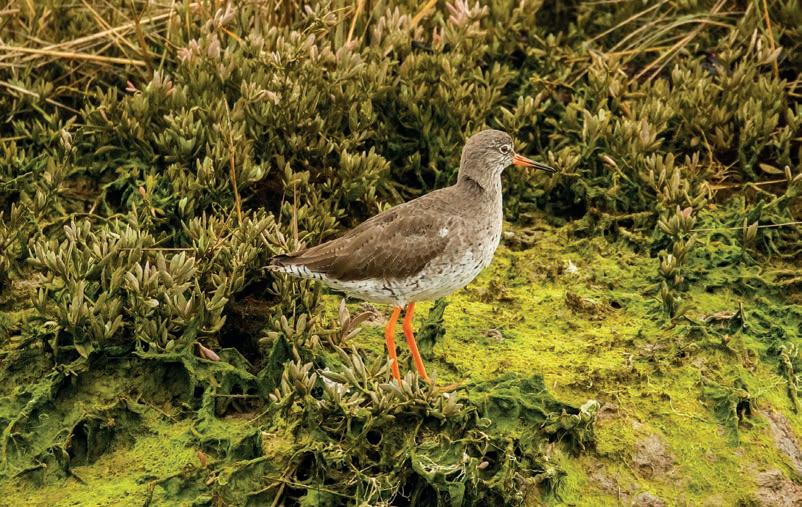
sheltered from the worst of the storms. It means that for this small section at least, productivity is more secure than other areas of the harbour.
The project was multifaceted, with landscaping around the islands to gain the material necessary to build them up. This left a landscape with lots of dips and hollows where water will collect as we progress through the summer. This means as the Deeps dries out, as it does every summer, areas of mud will be exposed for our migratory waders such as green sandpiper, creating a much better feeding habitat. The shingle is also a fantastic roosting space for the harbours’ winter waders. Only a few weeks after their creation, they were hosting a number of different species, such as dunlin, lapwing and oyster catchers.
Impact of climate change
Despite Farlington being a longestablished site, there is always opportunity for improvement, and this is vitally important as we adapt to climate change going forward. We have a plan to help adapt Farlington to hotter summers and more turbulent springs, helping the site to retain water and support our breeding waders.
All this aside, Farlington has an uncertain future. Behind a sea wall, one day sea level rise will be too much for it and it will return to the harbour. What that will look like, we have some say in, but the loss of Farlington will no doubt be a significant blow to the harbour and the Solent. How we replace Farlington and if that is even possible is now a question we are looking at in detail. It is however very likely that the next generation will look out on the harbour and see a very different landscape. It is our job now to make sure that that landscape is not devoid of nature.
What to look out for in spring
Spring is the time to see breeding waders. Look out for displaying lapwing and their somersaulting flight, as well as calling redshank (left). Progressing through the spring, they will have chicks and the avocet will start breeding.
Wild Life | Spring 2024 21
JAMES WEST
FARLINGTON MARSHES
WEZ SMITH RSPB


for the ‘nest’ generation

Safeguarding ground-nesting birds


22 Wild Life | Spring 2024

Adelicate dance of life unfolds each spring as ground-nesting birds prepare for their breeding season. Between March and August, these remarkable birds rely on undisturbed ground to build their nests and raise the next generation.
Ground-nesting birds inhabit a diverse array of habitats, and we are incredibly fortunate to have such varied habitat across Hampshire and the Isle of Wight for our feathered friends. From the song of the skylark resonating through grassy meadows to the distinctive ‘peewit’ call of lapwing echoing across wetlands; and from the warbling scratchy song of the Dartford warbler amidst heathland gorse to the mysterious grunts and squeaks of woodcock emanating from the forest. As stewards of our natural heritage, it becomes imperative for us to understand, appreciate, and actively protect these ground-nesting birds and their habitats.
Simple scrapes
At Testwood Lakes Nature Reserve, a haven for wading birds, the seasonal fencing of scrapes during spring and summer provides a safe nesting ground for lapwings. Recognisable by their long crests, black and white patterns, and distinctive ‘peewit’ calls, males put on dramatic aerial displays, tumbling through the air, accompanied by their charismatic call during courtship. Females, diligent in their nesting duties, create simple scrapes in the mud, sand or grassland where they lay their eggs. By late spring, cute, fluffy lapwing chicks can be seen venturing out to forage under the watchful eyes of their parents. If the nest is threatened at all, the parents will attack or ‘mob’ the potential predators.
GROUND-NESTING BIRDS Wild Life | Spring 2024 23
DARTFORD WARBLER: JON HAWKINS
WORDS KATE GARNHAM Communications Officer
Kate is passionate about wildlife, and finds pure joy in venturing outside, exploring the great outdoors and learning about the wonderful wildlife in our local wild spaces.
Nightjars nest on the ground on heathland and in young conifer woods. They are amazingly well camouflaged: bark-like plumage helps them to hide among the undergrowth.

The conservation efforts at Testwood Lakes Nature Reserve have resulted in notable successes. Last year, we saw 25 lapwing chicks fledge (successfully making it to adulthood). We also saw breeding pairs of little ringed plover, oystercatcher, and redshank which marked a significant achievement for the Lower Test Valley – the first recorded instance of redshank breeding in two decades.
Heathland management
In north Hampshire, our collaboration with the MOD focuses on tirelessly protecting approximately 1,500 hectares of heathland habitats, crucial for species like the Dartford Warbler. Dependent on mature, dry heath habitat, particularly gorse in good condition, Dartford Warblers choose to breed under the protective cover of dense heather or compact gorse. Their grassy, cup-shaped nests host three to five eggs and can support up to three broods. Positive heathland management, coupled with milder winters, has resulted in an encouraging
increase in Dartford Warbler numbers, showcasing the positive impact of dedicated conservation efforts.
The conventional heathland management typically consists of tree and scrub management which helps keep the habitat open, along with bracken and gorse management, which is particularly beneficial for ground-nesting birds. A lot of bare ground creation also takes place, this is beneficial for a wide variety of insects including solitary bees and wasps. Woodlarks also like this short and low vegetation, upon which they feed on the insects on the ground. Many native reptile and amphibian species also make a home in the heathland habitats, including one of the UK’s rarest reptiles, the sand lizard.
Agricultural habitat
Wilder Nunwell, on the Isle of Wight, is our largest rewilding project. At Wilder Nunwell, our ‘farming with wildlife’ approach and giving wildlife and nature the space to thrive has already seen some exciting results. We have recorded 60 bird species with 28 of those listed on
In accordance with the Countryside and Rights of Ways Act (2000), visitors using open access rights must keep dogs on a short lead of no more than two metres between 1 March and 31 July each year for the protection of ground-nesting birds, and at all times near livestock.
Did you know?
Ground-nesting birds have some of the most superb camouflage in the animal kingdom, with eggs perfectly disguised to blend with the ground and vegetation. For example, coastal ground-nesting birds lay eggs that are patterned like pebbles among rocks on the shoreline.
the Birds of Conservation Concern 5 list, including ground-nesting birds such as snipe and skylark.
The song-flight of the skylark is unmistakeable. Male skylarks hover effortlessly, singing from a great height, before parachuting back down to earth. These long and complicated song-flights can last for up to an hour and the birds can reach 300m before descending. Despite their aerial activities, skylarks nest on the ground, laying three to four eggs. Chicks become independent after only two weeks and parents can have up to four broods in a breeding season.
We are hopeful that the next few years at Wilder Nunwell will see more birds returning to their habitat with breeding numbers rising.
Nesting nightingales
The melodious song of the nightingale is the most likely sign of this bird being present. Shy and secretive, it nests low to
24 Wild Life | Spring 2024
GROUND-NESTING BIRDS
DAVID TIPLING/2020VISION
 JOHN BRIDGES
JOHN BRIDGES
3km west of Botley Woods and historically held nightingales. By assisting in Botley Woods, we hope that populations will expand and reoccupy Swanwick Lakes in the future.
Minimising disturbance
the ground in dense scrub and woodland and can be heard singing day and night.
The Trust’s Solent reserves team have spent three winters working in Botley Woods to provide habitat for the drastically declining nightingale. Botley Woods and the neighbouring woodland is one of Hampshire’s strongholds for nightingale, but the numbers are still worryingly low. It is important that the habitat is in perfect condition for this species to remain, and to begin to grow the local population. The Trust has been offering advice to Hampshire County Council, who own the woodland, and working with their rangers on the practical management required to create the perfect scrub conditions needed by the birds.
Swanwick Lakes Nature Reserve is
Despite our best efforts, ground-nesting birds across our two counties are in worrying decline due to habitat loss, climate change, and disturbance. Nesting on the ground makes them vulnerable to predators, but evolution has equipped them with survival strategies like camouflage to avoid detection.
Disturbance, especially from humans and dogs, is a major threat. Even wellbehaved dogs can appear threatening to ground-nesting birds, causing trampling and the disturbance of adults from their nests leaving eggs or chicks extremely vulnerable.
Despite our notable successes, not all of our nature reserves are thriving with ground-nesting birds. For example, at Emer Bog and Baddesley Common Nature Reserve, nightjar and woodlark nesting has ceased due to disturbance. Even though the habitat is suitable, no nesting young have survived in recent years. Curlews are also at serious risk in our counties, with no breeding observed due to recreational pressures.
We can all help ground-nesting birds by following on-site signage on nature reserves, sticking to footpaths, and alerting others to ground-nesting bird presence. If you notice distress signals from birds, back away and take an alternative route. While dogs on leads are permitted on the majority of nature reserves, please remember they must be on a lead and to bag and bin dog poo. Poo can affect wildlife and alter the habitats of ground-nesting birds so dispose of it properly. By minimising disturbance, we contribute to the survival of these vulnerable species and hope to see increased breeding numbers and presence of ground-nesting birds over time.
Four nature reserves to visit this spring
Farlington Marshes Nature Reserve
This 125 hectares of species-rich grazing marsh and saline lagoon has unrivalled birdwatching opportunities and wonderful walks all year round. In spring and summer, watch out for breeding avocet, lapwing, redshank, meadow pipit and skylark.
Bouldnor Forest Nature Reserve
This fascinating site is rich in prehistoric history, featuring a wonderful pine forest and heathland. Visit at dusk to potentially spot or hear the well-camouflaged nightjar.
Barton Meadows Nature Reserve
Meander through the blooming wildflower meadows in the spring and summer and listen out for skylark, yellowhammer and linnet singing from the rough grassland, hedgerow and trees. Sadly, due to disturbance we have to fence off areas to stop the skylarks being disturbed from their nests.
Hook Common & Bartley Heath



Wander through the heather, purple moor grass and secluded glades and discover the ancient wood pasture that’s bursting with wildlife. Look carefully for snipe and woodcock –their mo led plumage provides them with excellent camouflage.
Wild Life | Spring 2024 25
Above: Male skylarks rise from the ground in display song-flights that can last from several minutes to an hour.
GROUND-NESTING BIRDS
DAVE APPLETON
A small, rotund wading bird, the little ringed plover nests on bare gravel around flooded gravel pits, sandy riverbanks and reservoirs.


migrating birds 6 places to see









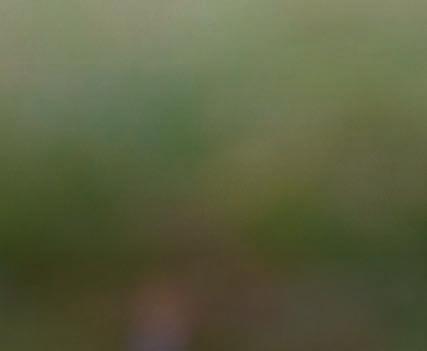

26 Wild Life | Spring 2024
CUCKOO © LUKE MASSEY/2020VISION

pring is a time of great change in the wild world. As the days grow brighter and warmer, millions of birds are on the move. They leave their winter refuges and race back to their breeding grounds, driven by the urge to find a mate and raise some chicks.
Cuckoos, ospreys, warblers and many more birds are returning to the UK from the warmer regions of southern Europe or Africa. They don’t all arrive at once; each species has its own schedule. Sand martins and wheatears begin arriving in March, but quails and nightjars are stragglers, appearing as late as May.

On some spring days, you can see migration in action, with flocks of birds flying overhead on their way to their summer home. Birdwatchers call this visible migration, or vismig for short. But flying is hard work, so keep an eye out for migrants stopping off to spend a few hours refueling before continuing their journey.
Here are six of the best Wildlife Trust nature reserves for experiencing spring migration.
Did you spot any migrators?
We’d love to know how your search went. Please send us your best photos by emailing webmarketing@hiwwt.org.uk or tweeting us @HantsIWWildlife

















See the spectacle for yourself




1 Cemlyn Nature Reserve, North Wales Wildlife Trust























An incredible site to visit on the wild coast of Anglesey, with its unique, shingle ridge. Cemlyn welcomes a wide range of wading birds and between May and July is host to nesting colonies of Sandwich, common and Arctic terns.
Where: Anglesey, LL67 0EA
2 Farlington Marshes Nature Reserve, Hampshire and Isle of Wight Wildlife Trust
Farlington is a coastal wildlife expanse with internationally important populations of wading birds and wildfowl. During the spring and summer migrations, the Point Field and bushes are hotspots for warblers and other small passerines passing through. Redstarts, spotted flycatchers, wrynecks, wheatears and whinchats are regularly spotted.
Where: Portsmouth, PO6 1UN
3 Blashford Lakes Nature Reserve, Hampshire and Isle of Wight Wildlife Trust
Blashford Lakes is a stunning nature reserve, well known among birdwatchers. Hundreds of sand martins migrate their wintering grounds to the reserve every year, taking full advantage of the artificial sand martin nesting wall.
Where: Ringwood, BH24 3PJ

4 Christopher Cadbury Wetland Reserve, Worcestershire Wildlife Trust


Worcestershire’s premier birdwatching nature reserve, Upton Warren attracts birds throughout the year. It is home to the UK’s first inland breeding avocets and attracts lots of wading birds while on passage as a vital stop over.
Where: Wychbold, B61 7ER
5 Walthamstow Wetlands, London Wildlife Trust
An internationally important site for migrating birds, Walthamstow Wetlands is excellent for an urban vismig. Just 15 minutes from central London, you will find a unique city oasis to connect with the magical world of migrating birds.
Where: Walthamstow, N17 9NH
6 Rye Harbour Nature Reserve, Sussex Wildlife Trust
In spring, gull numbers increase, and oystercatcher and dunlin feed along the shore and roost on the shingle at high tide. Gannets and flocks of Brent geese also return on their eastward passage to breeding grounds. Where: Rye, TN31 7FW
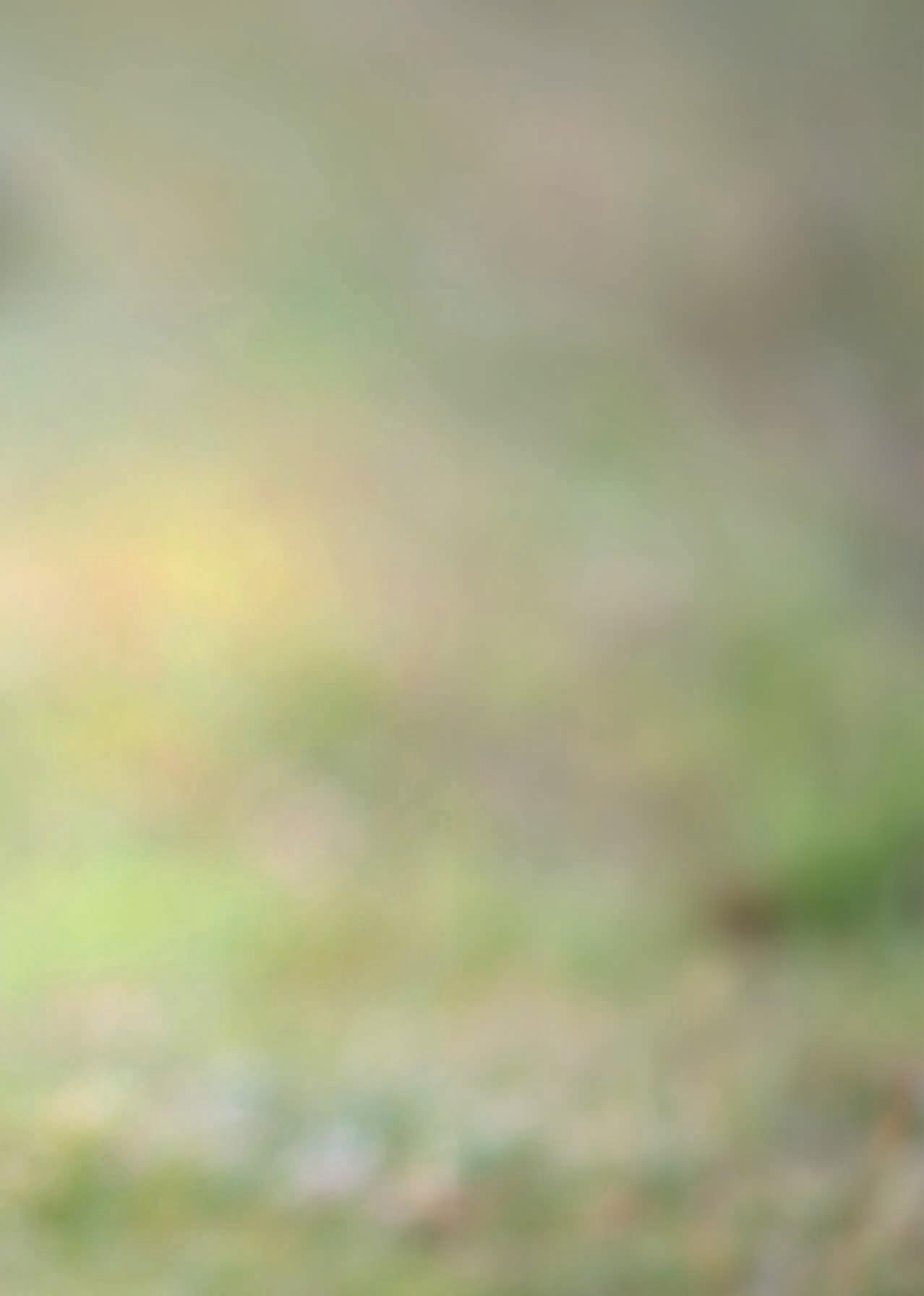



27

Grow a delicious herb garden
Herbs have been used around the world for their medicinal and edible qualities for millennia, estimated at 60,000 years ago!

 KATY
KATY

In the 6th century St Benedict drew up plans for how the monastic community should be laid out, which of course included a garden. This had to contain everything to sustain the life of the monks, and whilst the kitchen garden provided the food, the physic garden would contain all of the medicinal herbs. Those were the medicines in those days!
Not only are herbs great for us, but they also attract wildlife to gardens. Most people think of herbs for seasoning food, which of course they are excellent at doing. So, when I’m asked, ‘which herbs should I grow?’, invariably I reply, ‘the ones you like to eat’! And that’s the best place to start, as many herbs are better when they are repeatedly picked or cut, as they shoot new leaves, which are more flavoursome and potent than older leaves.
Herbs can be grown very easily in small spaces, indoors in a pot on a windowsill, or outside in a


window box, and adding more than one will widen your culinary additions. But do make sure the chosen plants like the same soil, water and light conditions.
An expert herb grower, Jekka McVicar, mainly grows her herbs in raised beds, easier on the back when gardening, but also means she can control the soil conditions and can contain those herbs that like to spread. If you only have a border but want to grow something like lemon balm that will quickly spread everywhere, put it in a large bottomless pot that will restrict the roots.
Herbs are a gateway plant to get people, especially children, gardening as they are easy to grow. And alongside this they attract bees, butterflies, moths, birds and other beneficial insects into the garden, so it’s win win. There’s not much else I like better than to take a hot cup of water into the garden and pick my own tea!



Arit Anderson is a garden designer, writer, podcaster and presenter for Gardeners World. She is also a trustee for the National Garden Scheme, Patron for Tuppeny Barn and Cultivate London, and an Ambassador for the RHS.
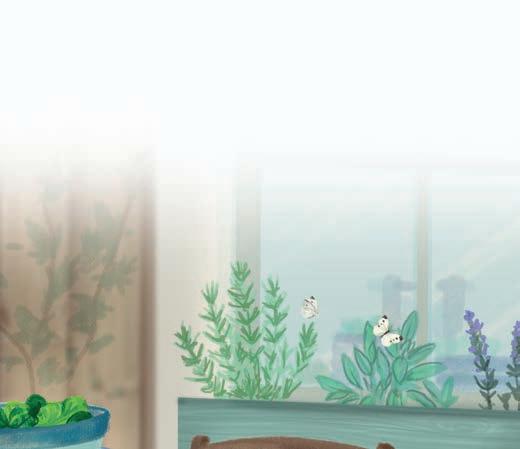


ILLUSTRATIONS
©
BY
FROST, ARIT HEADSHOT
JULIAN WINSLOW
28 Wild Life | Spring 2024

Borage
Copes with most soils and dappled shade and is a magnet to many pollinators. Borage flowers look super impressive captured in ice and served in drinks.

Thyme
Thrives in sun and welldrained soil and flowers throughout the summer, making this a popular herb with pollinators. With so many varieties to choose from, they’re great for cooking.

Lemon balm
Spreads easily so it is best to keep it in a container. Renowned for a racting bees and I grow this for making herbal tea.

Chives
A moist but well drained soil will keep chives happy, who in turn when flowering will keep many of our bees happy. The flowers are edible and look decorative in salads.

Wild marjoram
Otherwise called oregano, it’s a fantastic plant. Best in well-drained soil, bees and bu erflies love it and it’s great for flavouring Mediterranean dishes!

Fennel
Keep in light well drained sandy soil. Great for hoverflies and ladybirds and once they go to seed, birds can feed on them from autumn. One of my favourites.

Mint
Thrives in most soils, it’s so easy to grow and its flowers a ract bees, moths, bu erflies and other pollinators. A hardworking herb that li s salads, sauces and drinks! Loves to spread out – so contain in a pot if you don’t want a garden full.

Lavender
A sunny spot on welldrained soil is best. Bees and bu erflies can’t keep away! I had my first lavender scone on the Isle of Wight and it was delicious!
The Trust has joined forces with The Greening Campaign, which is empowering communities to tackle climate change locally. The Trust will be helping people to assess and map local areas, understand existing habitats, and develop plans to establish or improve natural spaces where wildlife can thrive. An array of community action resources will be available, including a new and improved wildlife gardening handbook. For more information, please visit: hiwwt.org.uk/team-wilder/greening-campaign

Wild Life | Spring 2024 29
GARDENING FOR WILDLIFE
MY WILD LIFE

Jamie Marsh
Jamie Marsh, Director of Nature Recovery Wilder Wight, Solent & Seas, has a long association with the Trust. Here, Jamie talks about growing up on the Isle of Wight, its wildlife, and the ambition to create a Wilder Wight.
I was born on the Isle of Wight and spent much of my childhood with my grandparents exploring the local countryside on long walks.
I have lots of vivid memories of wildlife encounters; watching hares boxing, seeing my first buzzard, watching fox cubs playing in the woods, but perhaps my most standout memories are those sat on the riverbanks of the Eastern Yar fishing with Gramps. It was in these moments that I really connected with
nature during times of stillness and tranquillity sat in silence watching a float bobbing in the water. Thus, my relationship with nature began.
I still love walking and getting outside. I am a keen birder, mother and butterfly enthusiast. I take my binoculars wherever I go – the just in case principle! I feel incredibly privileged to be based at our Wilder Little Duxmore site, not many people can boast about seeing marsh and hen harrier from their office window!
In school, I always favoured sciences and studied Environmental Biology at University. I then spent two years with the National Trust during which I learnt a huge amount from an amazingly experienced team. This was the foundation for my career in conservation.
I joined the Trust in 2007 as an assistant reserve officer. Over the past 17 years, I have been delivering reserve management across the two counties. I have been fortunate to have been responsible for the management of some
30 Wild Life | Spring 2024
“I love the intricacies of the relationships between species and habitats, the complexities around what seems to be straightforward management but underneath the surface are far more intricate.”
of the Trust’s flagship sites including Farlington Marshes, Swanwick Lakes and Arreton Down. From delivering and overseeing the practical management of the Trust estate, I now find myself in my current role which includes overseeing the Wilder strategy on my home patch. It has been quite a journey!
The profile of the Trust has increased significantly with the launch of Wilder Wight, our species reintroduction plans and the acquisition of new land has seen the Island estate quadruple in the past five years. This includes Wilder Nunwell which is very special to me. As well as my childhood stomping ground, it is also an estate where my grandparents and great grandparents worked. My great grandfather worked the woodlands producing coppice goods, my grandmother on the farm and my grandfather on the wider estate. For me, this is a fantastic legacy to be taking on from my forebears, restoring the estate to a natural landscape teeming with biodiversity and creating a Wilder Wight. Little did I know what the future held for me as I walked the lands of the Nunwell Estate in my childhood.
My role also includes overseeing the Wilder Seas programme. Our local marine environment is full of incredible diversity, an array of habitats and
species that are truly spectacular. Our marine work is focused on restoring key habitats, such as seagrass meadows, which provide so much for marine wildlife and people. Our marine community engagement teams also help promote this amazing local habitat and give people and communities the opportunity to learn more and get involved.
Working in this sector is more than a career, it’s a lifestyle choice. Those that work in this sector are driven and motivated by their love and passion for nature. It can be hard and challenging work, and the pressure over recent years has been intense, with world events and a biodiversity and climate crisis. However, the work is highly rewarding and despite the lows, we are making a real difference on a local level and pioneering new approaches that are being adopted nationally.
The impacts of climate change are becoming all too apparent. It’s not only impacts from weather but also more subtle changes like the changes in the structure of vegetation communities and species composition across all taxa. This includes the rise in invasive non-native species that already are causing issues but with the threat of more species on the horizon. The ramifications are likely to have a huge impact on how we manage our estate so a large amount of work is going on in the background, reviewing sites and planning for the future.

Wilder strategy with ambitious targets for land acquisition and influencing land management. It is internationally recognised that we need 30% of land for nature. New approaches to land management such as rewilding and the reintroduction of missing species are helping deliver landscape scale restoration, giving space to nature to recolonise and thrive. These new approaches are supported by our core estate of high value nature reserves where long term management has safeguarded important habitats and species. Now our mission is to connect these sites through targeted acquisition, linking up sites and restoring sites for nature delivering landscape scale conservation.
Below: “Our local marine environment is full of incredible diversity,” says Jamie.

What I love is that every day presents a new opportunity for learning. Our understanding of the natural world continues to grow, and our perceptions of wildlife are ever changing thanks to new approaches of managing land. The opportunities are vast and as we are demonstrating, nature conservation and restoration is deliverable on a landscape scale – we strive for a bigger betterconnected landscape.
Creating resilience and more space for nature is key and forms a central part of our
As with all our work and as a key part of our Wilder Strategy, engagement is crucial to the future of our natural world We can all make a difference to help – no matter how big or small. If we are inspired by nature, we will want to protect and enhance it for the future.
OUR WILDLIFE CHAMPIONS Wild Life | Spring 2024 31
Left: Jamie’s Great Grandfather, Maurice (standing), Grandad Jack (centre) and Uncle Stan as children, producing coppice goods on Wilder Nunwell land.
Leave a gif t in your Will
Birds are some of our most charismatic and easiest to spot wildlife species, and for many of us they are one of the first things that draw us to the natural world. Throughout their lives, numerous birds roam far across the landscape and they need us to protect and provide space for them, so that they can feed and rest when they come to spend time here in Hampshire and on the Isle of Wight.
Each year, funds donated through gifts in Wills are used to improve and protect vital bird habitat and maintain infrastructure on our reserves, including pathways and hides. These generous donors are helping to ensure that there is space for birds to continue to thrive and that we, and many more people like us, can continue to experience the joy of bird watching on our local patch.

Can you help to protect and create even more space for our local birds in the future by leaving a gift in your Will? It will cost you nothing now and can be of any size. All gifts are gratefully received, and all make a real impact for our local wildlife and wild spaces. Together, we can create a wilder future for everyone.
KINGFISHERS WITH MINNOW BY RICHARD JACOBS






 Helen Skelton-Smith, Editor
Helen Skelton-Smith, Editor

































 Debbie Tann MBE, Chief Executive X @Debbie_Tann
Debbie Tann MBE, Chief Executive X @Debbie_Tann
































 ALAN DUNK
ALAN DUNK











 JOHN BRIDGES
JOHN BRIDGES
































































 KATY
KATY





















